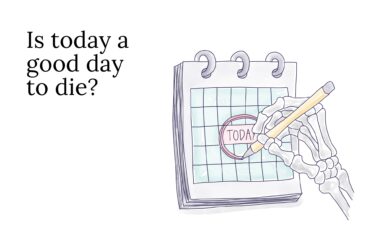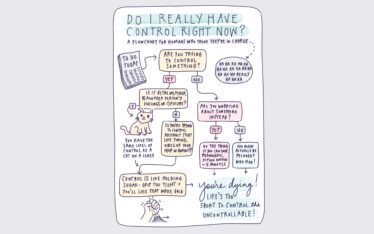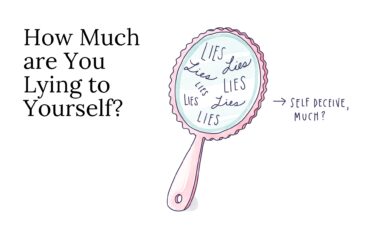Okay, here’s a warmup to the real test you came here for:
When you see this glass, what comes to mind?
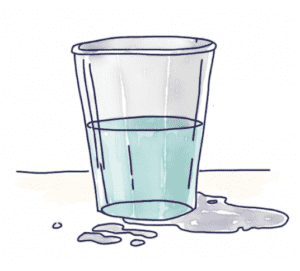 A) The glass looks half full.
A) The glass looks half full.
B) The glass looks half empty.
C) Where’s the mixer? And the ice? I don’t like my vodka straight up like that.
D) What kind of animal spilled all that liquid on the counter and didn’t clean it up?
If you answered A, C, or D, you’re going to turn out alright.
If you answered B, stick with me. Research is clear that optimism can be learned—without brainwashing!—so we can get you walking over on the sunny side of the street in no time.
What exactly is optimism?
Optimism is a pattern of thinking that drives how we feel, think, and act. An optimistic mindset believes that the future is going to be bright.
Wait—why do we care about optimism?
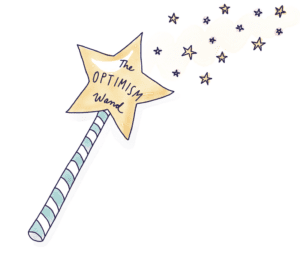
This, for the record, is not a vibrator.
Optimism is the magic wand of well-being (not to be confused with the thing that came up when I Googled “magic wand” for inspiration while drawing this little doodle for you. Great. If I was a pessimist, I’d say “MY SEARCH ALGORITHIM IS FOREVER DOOMED,” but because I’m an optimist, “I can handle sex toy remarketing” is what I’m saying instead).
Optimism can be scientifically credited with scads of things that we want in life, including but not limited to:
- Increased mental and emotional well-being
- Elevated resilience
- Better physical health (over a 30-year period, optimism was linked to a better outcome on eight measures of physical and mental function and health, like blood pressure, immune system functioning, recovery from illness, etc. ad nauseum)
- Strengthened relationships
- Increased success and productivity
- Less death (that sounds flippant but “positive attitudes have a long-standing impact on prognosis in old age”)
- Minty fresh breath
Two ways to look at optimism:
Optimism can be viewed according to our explanatory style—how we explain or attribute the positive and negative events that fill our days.
Pessimists believe shit-sandwich-situations in life are personal (“It’s me, myself, and I who’s totally to blame for making this crappy sandwich”), permanent (“I will always be served stool sandwiches, until the day I die”), and pervasive (“I guess this sandwich stench is going to spill over into all the other non-shitty parts of my life and make them crappy, too”).
Optimists typically believe they are not the ones to blame when things go awry, they see setbacks as temporary, and they can isolate bad news without having it invade their entire existence.
Optimism can also be seen as a dispositional trait—whether we believe (or fail to believe) that the future will be bright. We can measure our dispositional optimism through what’s known as the Revised Life Orientation Test (LOT-R) … which we’re going to do right now.
Please answer the following questions about yourself by indicating the extent of your agreement using the following scale:
0 = I disagree a lot
1 = I disagree a little
2 = I neither agree nor disagree
3 = I agree a little
4 = I agree a lot
Be as honest as you can throughout, and try not to let your responses to one question influence your response to the other questions. There are no right or wrong answers.
- In uncertain times, I usually expect the best.
- It’s easy for me to relax.
- If something can go wrong for me, it will.
- I’m always optimistic about my future.
- I enjoy my friends a lot.
- It’s important for me to keep busy.
- I hardly ever expect things to go my way.
- I don’t get upset too easily.
- I rarely count on good things happening to me.
- Overall, I expect more good things to happen to me than bad.
- I believe the world needs more nachos.
Scoring:
- Reverse code items 3, 7, and 9 prior to scoring (0=4) (1=3) (2=2) (3=1) (4=0).
- Sum items 1, 3, 4, 7, 9, and 10 to obtain an overall score.
- Note: items 2, 5, 6, 8, and 11 are filler items only. They are not scored as part of the scale. Science… it keeps you on your toes!
Results:
- If you scored 0-13, you are likely Low Optimism/ High Pessimism
- If you scored 14-18, you are likely Moderately Optimistic
- If you scored 19-24, you are likely High Optimism/ Low Pessimism
So . . . now what?
The goal is to be thoughtfully optimistic . . . which is not to be confused with cockeyed optimism (sing-song-ing that “EVERYTHING’S GOING TO BE FABULOUSLY FINE!!!” as the ship hits several icebergs and then sinks to the bottom of the ocean). No, cockeyed optimism gets you killed. Speaking about perishing . . .
Pessimism might also get you killed. Covertly. Researchers explain, through oodles and oodles of studies, that “a pessimistic explanatory style… is significantly associated with mortality.” GUYS. We’re here trying to live like we mean it before we die, not half-glass-full-ourselves to an EARLY GRAVE.
Pessimism-in-poor-disguise might also get you killed, mostly because you’re annoying. You are a pessimist in disguise if you preface your downer diatribes by saying things like, “I’m just being a realist.” We can all see through your ruse, and we see your mental and physical and spiritual and emotional and all the others healths DYING (because as mentioned, optimism boosts health and pessimism busts it). The Grim Reaper has a heart-shaped PESSIMISM tramp stamp tattoo and that should tell you something.
3 do-able ways to increase optimism:
- Expect and accept. Expect shit to go down (it’s life after all), and accept it. Practice equanimity, again and again until the day you’re all decked out in your coffin. Sometimes our expectations about life/ love/ work/ our hair are out of whack and we need to recalibrate.
- Ramp up the gratitude. If optimism the magical wand, gratitude is the salve that cures almost all woes. When you’re having a hard time looking on the bright side, pause and write out a few good things going on. “The sun came up today. It might not tomorrow, but it did today. So that’s good I guess.” (That is a sad but acceptable example.) Read more on gratitude here. And here, for sure.
- Reframe the crappy times. Winston Churchill said that “a pessimist sees the difficulty in every opportunity; an optimist sees the opportunity in every difficulty.” Sometimes a turd is just a turd, but other times you’re just overlooking the vastly beautiful park that rolls out for miles around the doggy do-do you’re narrowly focused in on. Can you find something serendipitous? Can you celebrate your snafus? Can you ask yourself if your negative thoughts are actually true (because often they aren’t)?
- Emulate a glass-half-full role model. Catch yourself when you’re in a pessimistic mindset and ask yourself what an optimistic friend might say in the same situation. After scoffing at it, try it on for size.
As always, awareness is the precursor to change. If you identified as a pessimist in the assessment above, remember that there is still hope (even though every bone is your bone is pre-programmed to say, “THERE IS NO HOPE”). I believe your future is bright. And you do a bit more now too, right?

P.S.: Let’s Instagram!
P.P.S.: Oh and just in case you missed it… I’d love you forever if you took 16 minutes out of your life to watch my TEDx talk!




